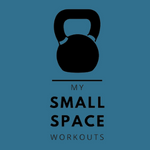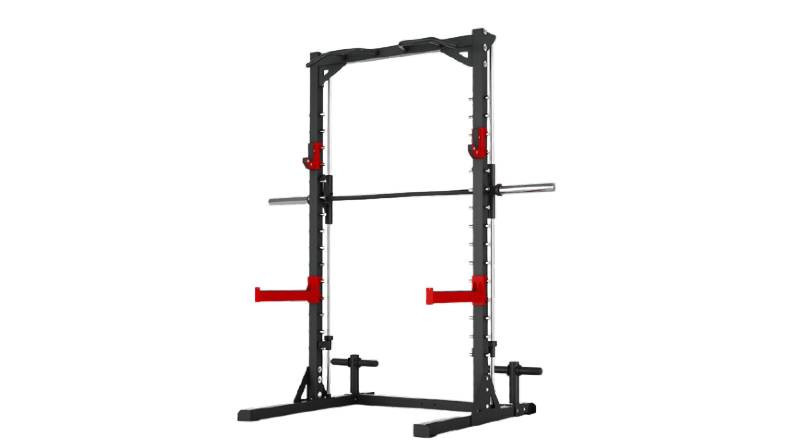If you’ve ever wondered whether you can deadlift on a Smith Machine, then you won’t want to miss this article. While it is possible to deadlift on a Smith Machine, you need to be aware of the advantages and disadvantages of doing so, as well as understand how to perform the deadlift on the Smith machine with correct form. We cover all those points and more in this guide to deadlifting on the Smith Machine.
[lwptoc]
What is a Smith Machine
If you’ve ever been in a commercial gym, you will have probably seen a Smith Machine. They are essentially an Olympic Barbell fixed to a vertical frame so that the bar moves up and down in a single plane of motion.
The bar of a smith machine is manufactured with hooks on it so that the user can hook the weight back on to the frame along a series of machined slots running the length of the vertical frame.
The idea is that the user can perform weightlifting movements without a spotter, knowing that should they reach the point of failure during a rep, they can simply rotate the bar with their wrists and secure the bar into one of the slots.
If you’re wondering why its called a smith machine its because Rudy Smith, an executive of the Tanny’s chain of gyms in the 1950s, enhanced and took to market an earlier design of the machine invented by Jack LaLanne, an American fitness legend.
I guess the LaLanne Machine just wouldn’t have the same ring to it!
So that’s what the Smith Machine is and how it came into existence, but you may be wondering how people use it?
People perform many different exercises on the Smith Machine, but the most popular exercises to perform on the Smith Machine are:
- Shoulder Press
- Bench Press (flat, Incline, Decline)
- Squats (hack squat and front squat work best)
- Hip Thrust
You’ll note that there was no mention of deadlift there. You’ll find out why in the “disadvantages” section below!
How To Deadlift On A Smith Machine
If you want to watch a good video demonstration of a Smith Machine Deadlift then YouTuber Korin Sutton has got you covered.
Here’s a breakdown of the movement:
- Approach the bar, which should be about thigh height.
- Stand close to the bar so that its nearly touching your thighs.
- Hold the bar with a mixed grip
- Rotate the bar off its hooks and stand up straight, taking the weight
- Slowly descend, hinging at the hip, keeping your back straight with only a moderate bend at the knee
- Now explode back to the starting position by engaging your hamstrings and glutes
So, that’s how you perform a deadlift on a Smith Machine, now let’s consider the advantages and disadvantages of doing so.
Advantages of Performing a Deadlift on a Smith Machine
The main advantage of deadlifting using a Smith Machine is that you pretty much isolate your hamstrings and glutes.
By standing close to the bar as described above, you will be forced to push your buttocks backward and hinge at the hip.
This will stop you from arching your back and putting too much strain on your lower back.
Another advantage is that you will find it easier to keep constant tension in your muscles throughout the entire set than you would with a free weight deadlift. This is because the barbell never touches the ground on the Smith Machine deadlift so momentum is never broken – providing that you don’t intentionally rest the bar, of course.
If you’re training around a specific injury, Smith Machine deadlifts can be a useful tool in your rehabilitation given that you aren’t required to stabilize the weight and can complete the set in a slow and controlled manner.
So far so good, but are there any disadvantages of deadlifting on a Smith Machine?
Disadvantages of Performing a Deadlift on a Smith Machine
By performing deadlifts on a Smith machine you are taking one of the greatest compound movements and turning it into an isolation exercise.
In the case of squats, a 2009 paper in the Journal of Strength and Conditioning Research reported that muscle activation “…during the free weight squat was 43% higher when compared to the Smith machine squat.”
Okay, so that study looked at squats but it stands to reason that a similar result would be reported with other exercises, especially the deadlift.
This is because the barbell on the Smith Machine runs on a fixed plane of motion, whereas in free weight exercises you have to stabilize and control the bar throughout the full range of the movement.
The deadlift is so effective precisely because of the level of whole body engagement it demands!
So, unless you are training around an injury, why would you want to deadlift on a Smith Machine?!
Talking of injury, while many people consider that the Smith Machine is safer than lifting free weights, we’re not sure that’s entirely true. By forcing your body to work in a fixed plane of motion, you run the risk of injury when lifting heavy, as you override your body’s natural biomechanics.
As you can see there are some significant drawbacks to using a Smith Machine for your deadlifts. This is why they are not considered a popular exercise to perform on the Smith Machine.
Final Thoughts
Whether or not you choose to deadlift on the Smith Machine comes down to a matter of personal choice.
We’d say that free weight deadlifts and Smith Machine deadlifts are actually completely different exercises and both of them can have a place in your strength training routine.
While the Smith Machine is mainly to be found in the gym, there are now some excellent, affordable Smith Machines available which have been designed and priced for the home-gym environment. So you shouldn’t discount them if you have been wondering about making the investment.
I hope that you’ve found this article useful and that its helped you to decide whether you will be incorporating Smith Machine deadlifts into your own workouts.
But before you go, remember to let me know of your experiences of deadlifting on the Smith Machine in the comments! And if you’re left feeling that a Smith Machine isn’t for you, then why not check out our rundown of one of the most versatile pieces of kit you could ever equip your home gym with!

